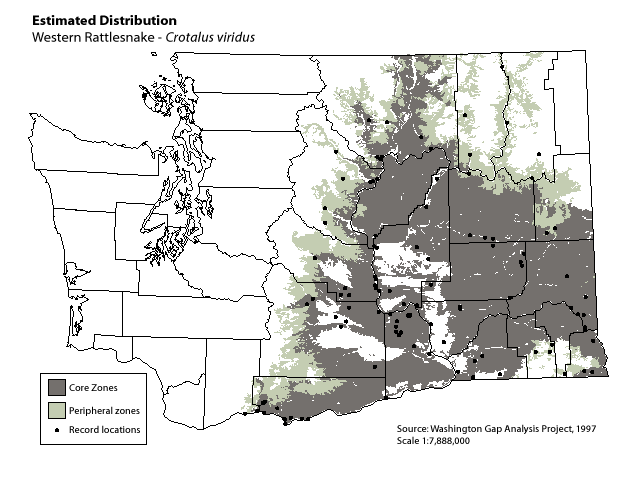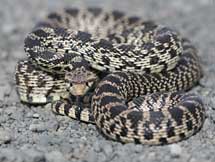Rattlesnakes in eastern Washington are western rattlesnakes or Crotalus viridis. Several subspecies of western rattlers inhabit western and midwest states such as the northern Pacific rattlesnake or Crotalus viridis oreganus in Washington, Oregon and California; prairie rattlesnake or Crotalus viridis viridis inhabiting a swath east of the Rocky Mountains from the Dakotas to Texas, and great basin rattlesnake or Crotalus viridis lutosus and others inhabiting the desert southwest. The map below shows areas with habitat favorable to western rattlesnakes in Washington State based on ecological region, land cover and elevation, courtesy of the University of Washington.
Rattlesnake information
Eastern Washington State

» Eastern
Washington rattlesnake pictures
» Eastern Washington snake pictures
» Eastern Washington reptiles
» Eastern Washington wildlife
» Eastern Washington animals and plants
Related information
Where are rattlesnakes found in Washington State?
The
Western Rattlesnake - BC
Rattlesnakes!
Behavior, natural history, precautions
Fear
factor figures in snake study - Seattle Times
Rattlesnakes
- Washington State University
Living with Wildlife - Snakes
Books
Rattlesnakes
Venomous
Reptiles of North America
Rattlesnake:
Portrait of a Predator
Snakes:
The Evolution of Mystery in Nature
Rattlesnakes:
Their Habits, Life Histories, and Influence on Mankind
The
Ultimate Desert Handbook : A Manual for Desert Hikers, Campers and Travelers
Desert
Survival Handbook : How to Prevent and Handle Emergency Situations
The rattlesnakes encountered in eastern Washington typically display fear of people and slip away, rattling meekly, or they may act docile -- staying put and remaining quiet when approached-- this behavior seems typical during cooler times of day or night, and/or when damp. They're more jumpy in the heat though.
These rattlesnakes are are a little over two feet long, many between one and two feet. Their color can be brown against a tan/white background to olive against a dusty light green background. Rattlesnakes make a distinctive sch-sch-sch-sch rattling sound when disturbed. Grasshoppers may make a similar sound, more like rapid clicking than rattling. To listen to a rattler recording, click the recording of an Eastern Washington rattlesnake.

Harmless gopher snake
Over many years of travelling eastern Washington I've heard of one person getting bitten by a rattlesnake and don't let it get in the way of exploring new places -- the truth is, they can be hard to find. However, snake bites do happen, and it's sensible to be wary of rattlesnakes, mainly to be aware when travelling where they live and look where you step or grab hold. It's also a good idea to wear boots covering the ankles and walk with a stick. A certain amount of fear or waryness is an appropriate instinct but that said, available data shows snake bites are relatively rare, mortality extremely rare, and most bites are easily preventable in the first place. Here are some statistics on snake bites from credible sources, to illustrate the level of danger posed by rattlesnakes and other venomous snakes:
- Approximately 8,000 people a year get snakebites from all venomous species in the U.S., 9 -15 victims die. (FDA) - U.S. population is about 300,000,000 (U.S. Census)
- 25% of adult Rattlesnake bites are dry, with no venom injected. (Brown, 1997)
- Rattlesnakes can only strike a distance equal to 1/2 their own length
- 85% of the natural bites are below the knee. (cited by University of Florida)
Of the bites mentioned above, most are due to handling pet snakes or tormenting
wild ones. This article from GORP helps clarify these statistics and illustrates
the importance of not harassing rattlesnakes:
Epidemiology
and the Risk of Snakebite.
In any case, it's good to know what to
do and not to do in case you or someone you're with gets bitten. The difficult
thing to keep in mind is to treat it as a medical emergency, yet keep
the bite victim calm and get him to a hospital. This article by the FDA
covers the subject well:
Treating and
Preventing Venomous Bites
In addition, here are some ideas for people worried about rattlesnake bites to reduce risks:
- Talk to kids pointedly about snakes-- let very young ones know snakes can bite and that bites will hurt, and especially try to impart good judgement to teenage boys to help dissuade them from poking with sticks or counting coup. Instilling some fear is good but promoting phobia is not -- exaggerated fear can result in an inability to take basic precautions, instill shock as the response to minor situations, and can last a lifetime.
- Write down phone numbers and locations for the nearest hospitals and clinics where you're going.
- Bring a cell phone when you're out & about, if you have one-- it may not work everywhere you go but may come in handy in open country where there's a good signal.
- Bring good walking boots.
- Bring a walking stick.
This page is provided for people who live east of the Cascade mountains or are interested in visiting eastern Washington just to explore, or to search out and see these beautiful animals in their natural environment. There's little to worry about and much to look forward to seeing, and it's always a better to be prepared and not need it than need it and not be prepared.
For more information about rattlesnakes, snakebite and children, and to see what other wildlife can be seen in eastern Washington, follow the related links to the left.

